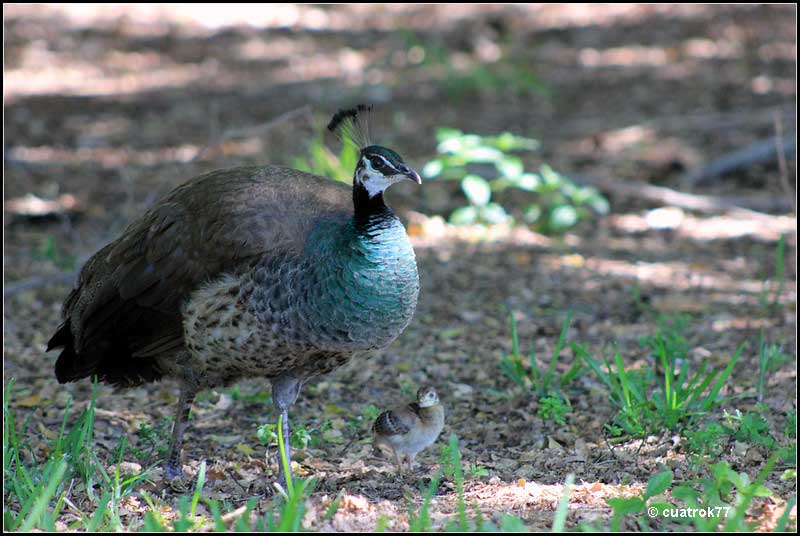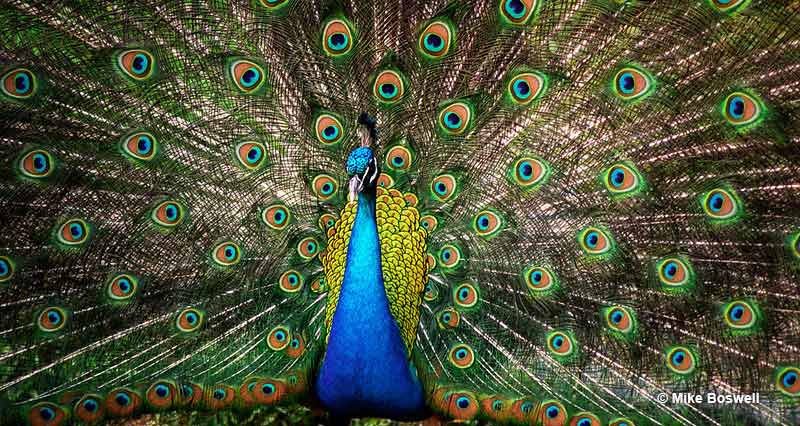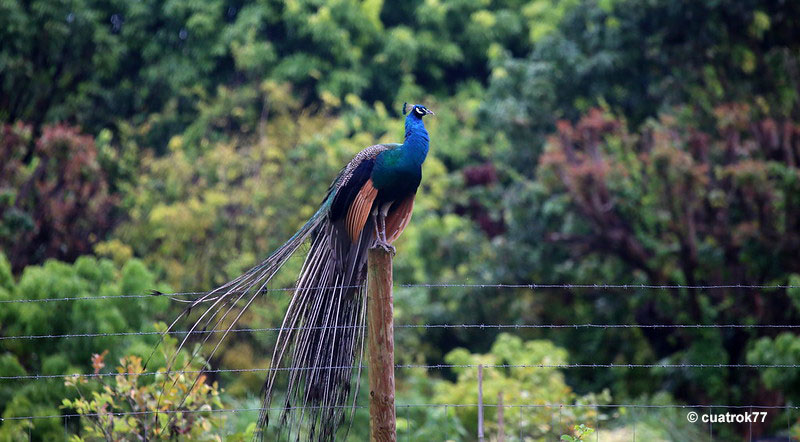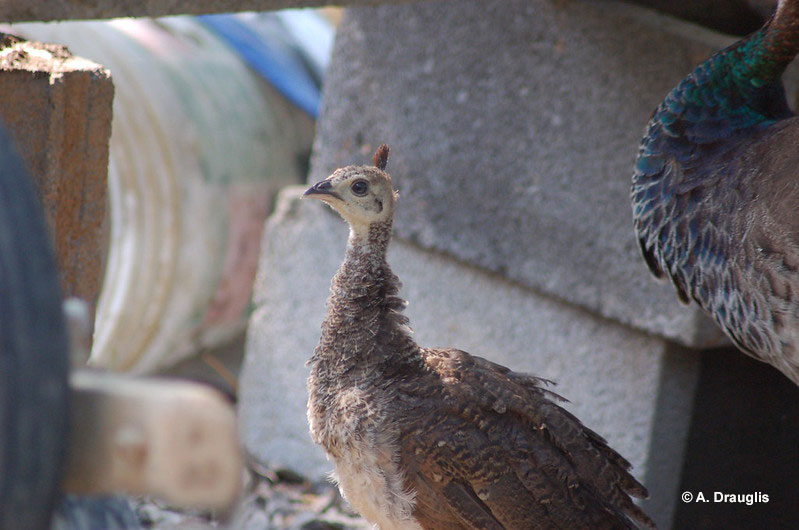
Peacocks are simply spectacular. With their huge, iridescent tails, these bold and beautiful birds are much more than “fancy” or “exotic”. In some places, these huge pheasants are also common and easy to see!
Since their habits are a lot like chickens, peacocks are also easy to take care of.
But how long do peacocks live? Can they live for decades or only survive for a few years?
On this page
How Long Do Peacocks Live?
Although peacocks are common birds in much of their range, very few studies have investigated their lifespan in the wild.
Related: What do peacocks symbolize?
To make a good assessment of their lifespan in the tropical scrub and forest habitats of India, biologists would have to catch several peacocks, put tracking devices on them, and keep track of the birds for many years.
That would be such a tough and long project; no wonder no one has done it!

However, we can use information about captive birds to make fair guesses about the lifespans of wild peacocks.
In general, since domesticated Indian Peacocks can live for several decades, wild peacocks probably have an average lifespan of 12 to 15 years.
That lifespan would be similar to several other birds that can live for 30 or even 40 years in captivity but have a wild lifespan of 15 or 20. No doubt, a few wild peacocks live longer but probably not more than 30 years.
Do domesticated peacocks live longer?
Similar to most captive animals, domesticated peacocks live much longer than their wild counterparts. These big, beautiful birds have been known to live for 40 years, and there have even been rumors of peacocks living to be 50!
With good veterinary care and proper feeding, most domesticated peacocks survive to be at least 25 or 30 years. Several can also live longer, especially when they are regularly checked for diseases and taken care of.
Most of all, they don’t have to worry about predators that catch most older peacocks in the wild.
Biggest Dangers
In the wild, peacocks have to deal with several issues. The big, beautiful birds are actually common in many parts of India, especially in protected areas and around villages that protect them for religious reasons.
However, in places where peacocks are not revered, they are often hunted and become very rare or eliminated.
They are also affected by the conversion of natural scrub and dry forest habitat to farmland and pasture. Although peacocks can still feed in some of those areas, substantial numbers can die from pesticide poisoning.

In some places, peacocks are also susceptible to being hunted by stray dogs, especially young birds. In wilder areas, several predators also prey on young and adult peacocks. Their natural predators include Leopards and other wild felines, Jackals, and Dholes (a type of wild canine).
Large birds of prey also catch peacocks. In the Indian subcontinent, such predators include Eagle Owls and Hawk-Eagles (large tropical raptors similar to big goshawks!).
Like other birds, their nests and young are more likely to fall prey to various animals. Mongooses, in particular, can take eggs and baby birds, especially in Hawaii, where the small predators are an abundant introduced species. Large lizards and some snakes might also take young peacocks.
The Life Cycle Of Peacocks
Wild peacocks start breeding around two to three years old, once per year. In regions that have wet, tropical vegetation all year long, they can breed any month. However, in most places, they start breeding at the onset of heavy seasonal rains.
For example, in much of India, their breeding is related to the monsoon season and starts in July or August.
Shortly after the rains start, female peacocks (peahens) pick a nesting site and lay their eggs. They usually make a shallow scrape on the ground, below a low, thick bush.
In villages where they are protected, peahens can also make their nest on a roof, on top of another structure, or in rice paddies and sugarcane fields.
She typically lays 4 to 6 eggs and incubates them for 27 to 30 days. A few hours after hatching, the baby peacocks are able to walk and they follow their mother around. She leads them to feeding areas and keeps them safe by bringing them to spots with dense cover.
After two weeks, when the babies can run, she brings them to more open areas and they also roost with her in trees at night.
The young birds depend on their mother for the next nine months.

Can You Tell How Old A Peacock Is?
Identifying peacocks by age is easier said than done. For younger birds, it is easier to tell their approximate age, but as they grow, adult birds are only identified by sex. For example, peacocks have downy plumage that is dark above and pale below when they are anywhere from a week to nine weeks of age.
By nine weeks, they have a pale head and a small crest and are light brown above and yellow-white below with a brown chest.
Eventually, young birds molt in adult feathers bit by bit when they are two years old. By the age of three, they have full adult plumage, and we can tell female peacocks from male peacocks.
From that point on, we can’t really tell how old a peacock is, unless they’ve had the same owner (or some sort of knowledge). However, when they are 20, the bird’s plumage can start to look worn and have some paler feathers.
Did You Know?
- A young male peacock has a smaller tail than adult males that are three or more years of age.
- Some snakes can catch baby peacocks but they have to be careful; peacocks attack and eat many snakes!
- Baby peacocks are vulnerable, even in captivity. If they don’t receive enough nutrition, they can perish.
- Peacocks in captivity can catch the same diseases that affect poultry. Farms need to be careful about keeping these birds near each other.
- In the wild, peacocks are wary birds that make loud calls when they become alarmed. To escape predators, they fly into trees.
- The related Green Peacock of southeastern Asia is much more endangered than the Indian Peafowl. Unlike that species, the Green Peacock is not revered, and is often hunted.
- Many Indian villages protect peacocks because the birds can drive away snakes, even venomous ones.
- Peacocks need to eat twice per day and require a varied, protein-rich diet.
- In the city of Los Angeles and some other places, feral peacocks occasionally cause problems when they raid gardens and destroy flowerbeds.
- Both male and female peafowl live for the same amount of time.
Frequently Asked Questions
How old was the oldest peacock?
The oldest peacock is rumored to have lived for 50 years.
Do Peacocks mate for life?
Peacocks do not mate for life. They can pick a different mate each breeding season.
Can a Peacock survive alone?
Peacocks can survive alone, but not as long as peacocks that live in small flocks. They are quite social birds, so they thrive in groups.

